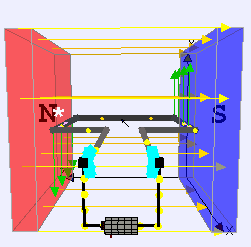ELECTRIC
MOTOR
An electric motor is a rotating device which converts electrical energy into mechanical energy.
It means it takes energy from electricity and using this energy the motor system rotates its rotator. The motion of rotator means that it possesses mechanical energy.
It appears so simple but we have to understand the process by which this energy change take place.
The basic principle behind the working of motor is that when a current carrying wire is placed in a magnetic field it experiences a force. The direction of this force can be determined by Fleming’s left hand rule.
Thus using electrical energy we setup an electric current in a coil
and in an electromagnet. The electromagnet thus behaves like a magnet. The current carrying coil when placed in magnetic field of electromagnet experiences a force. Using suitable arrangement and designing, the coil can be made to rotate.
Construction
A simple electric motor consists of a rectangular coil ABCD of insulated copper wire placed between two opposite poles magnets as shown in the figure. The ends of the coil are connected to two half of a split ring (S1 and S2) attached to the axle. The split rings are connected to two carbon brushes B1 and B2 as shown in the figure. The carbon brushes are connected to a battery through connecting wire and a key (or switch).
Let the plane of coil is initially placed horizontally as shown in the figure. The direction of current in the coil is along ABCD. The direction of magnetic field is from North pole to the south pole.
By applying Fleming’s left hand rule on arm AB, the direction of force on arm AB is downward. Similarly the direction of force on arm CD is upward. Under the action of two equal and opposite will make the coil mounted on an axle to rotate anticlockwise.
Second Half Cycle
After half a rotation, arms AB and CD will interchange its position. The split ring S1 is now in contact with brush B2 and the split ring S2 is in contact with brush B1. The direction of current in the coil is now DCBA, reversed as compared to first half cycle. A device which reverses the direction of current in a circuit is called commutator. In electric motor, split rings acts as commutator.
By applying Fleming’s left hand rule on arm AB, the direction of force on arm AB is upward. Similarly the direction of force on arm CD is downward. Again under the action of two equal and opposite will make the coil mounted on an axle to rotate anticlockwise.
By applying Fleming’s left hand rule on arm AB, the direction of force on arm AB is downward. Similarly the direction of force on arm CD is upward. Under the action of two equal and opposite will make the coil mounted on an axle to rotate anticlockwise.
Second Half Cycle
After half a rotation, arms AB and CD will interchange its position. The split ring S1 is now in contact with brush B2 and the split ring S2 is in contact with brush B1. The direction of current in the coil is now DCBA, reversed as compared to first half cycle. A device which reverses the direction of current in a circuit is called commutator. In electric motor, split rings acts as commutator.
 |
| ©Udvita.org |
By applying Fleming’s left hand rule on arm AB, the direction of force on arm AB is upward. Similarly the direction of force on arm CD is downward. Again under the action of two equal and opposite will make the coil mounted on an axle to rotate anticlockwise.
Commercial motor
A commercial motor consists of an electromagnet instead of permanent magnets. The current carrying coil consists of a large number of turns (in thousands). A soft iron core is used on which the coil is wound.
The soft iron core along with the coil is called the armature.
 |
| Image credit-Abnormaal, Electric motor, CC BY-SA 3.0 |
Uses of electric motor
Electric motor is used in electric fans, water pumps, mixer, MP3 player, computer etc
Simplest Electric Motor
Watch the Simplest electric Motor video made by our YouTube Channel partner 'Learn n hv Fun'.
The motor is simply made using a copper coil and few neudymium magnets using a 1.5V electric cell.

